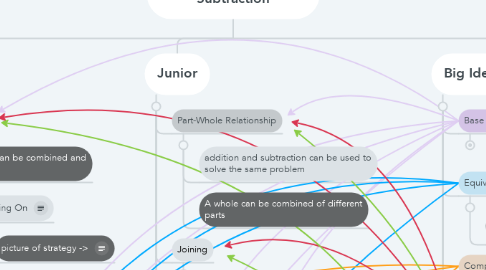
1. Primary
1.1. Parts of whole
1.1.1. these parts can be combined and separated
1.1.1.1. Counting On
1.1.1.1.1. picture of strategy ->
1.2. Identity Property
1.2.1. The number zero does not change another value
1.2.1.1. 0+30=30
1.3. Commutative Property
1.3.1. numbers can be combined in any order
1.3.1.1. 3+4=4+3
1.4. Associative Property
1.4.1. alternating grouping of the same numbers does not change the sum
1.4.1.1. 4+2+1 = 2+1+4
1.5. Models
1.5.1. counters
1.5.2. base ten blocks
1.5.3. number lines
1.5.4. tallies
1.5.5. hundreds chart
1.6. Basic Facts
1.6.1. adding one digits up to ten
1.6.1.1. multiples of ten, hundreds and thousands
2. Junior
2.1. Part-Whole Relationship
2.1.1. addition and subtraction can be used to solve the same problem
2.1.2. A whole can be combined of different parts
2.2. Joining
2.2.1. a problem with increasing amounts
2.2.1.1. Ann has $23 and then earns $78. How much money does Ann have?
2.3. Separating
2.3.1. a problem with decreasing amounts
2.3.1.1. Ann has $101 and spends $16 on a calculator. How much money does Ann have left
2.4. Comparing
2.4.1. a problem that looks at the relationship between two wholes
2.4.1.1. Ann buys 14 pieces of fruit and her sister buys 5 pieces of fruit. How many more pieces of fruit does Ann have?
2.5. Decomposition
2.5.1. numbers are made up of friendly numbers which can help us add and subtract
2.5.1.1. picture of strategy->
2.5.2. Splitting
2.5.2.1. picture of strategy->
2.5.3. Adding on
2.5.3.1. picture of strategy->
2.5.4. Compensation
2.5.4.1. picture of strategy->
2.5.5. Partial Subtraction
2.5.5.1. picture of strategy->
2.5.6. Compensation
2.5.6.1. picture of strategy->
2.5.7. Constant-difference
2.5.7.1. picture of strategy->
2.6. Models
2.6.1. base ten
2.6.1.1. importance of ones vs ten vs hundreds etc. and friendly numbers
2.6.1.1.1. picture of model ->
2.6.2. number line
2.6.2.1. open number lines
2.6.2.1.1. picture of strategy ->
3. Big Ideas Overview
3.1. Base Ten System
3.1.1. adding digits to discover the whole number
3.1.2. numbers can be shown as picture, numbers or words
3.2. Equivalence
3.2.1. there are many ways to decompose and express numbers
3.3. Comparison
3.3.1. numbers can be grater or less than each other
3.4. Operation Meanings and Relationships
3.4.1. real word problems can be solved with all addition and subtraction strategies
3.4.2. adding and subtracting are inverse functions
3.4.3. adding = greater, subtracting = less
3.5. Properties
3.5.1. numbers can be added in any order
3.5.2. zero added does not change the number
3.6. Basic Facts and Algorithms
3.6.1. breaking apart the unknowns
3.6.2. subtraction and addition are related

